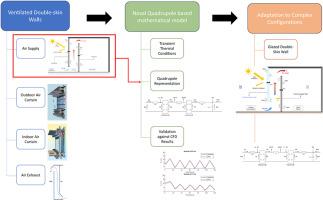基于四极杆的快速分析模型,用于解决通风双层墙体的瞬态传热问题并评估其节能潜力
IF 4.9
2区 工程技术
Q1 ENGINEERING, MECHANICAL
International Journal of Thermal Sciences
Pub Date : 2024-10-12
DOI:10.1016/j.ijthermalsci.2024.109463
引用次数: 0
摘要
本研究提出了一种快速准确的方法,用于模拟强制通风双层幕墙(VDF)的瞬态传热,以预测其节能潜力。该方法使用热四极形式主义,在拉普拉斯域中求解 VDF 问题,同时考虑热传递的全部瞬态性质;唯一的近似是空间近似。求解过程包括获得一个通用传递函数,该函数可预测通风空腔出口处的传热速率或空气温度。四极法与在类似气象、设计和边界条件下进行的计算流体力学数值模拟进行了验证。结果表明,两者的一致性非常好(平均偏差小于 3%),计算时间显著缩短(计算时间小于 3 秒,而 CFD 计算时间为 6 小时)。该模型计算效率高,可考虑墙体不透明度、建筑材料和气腔设计参数等重要因素。最后,与传统系统相比,该模型可以评估 VDF 在各种情况下的节能潜力,有助于促进更可持续的建筑设计实践。VDF 配置的能源效率与传统墙体系统进行了比较。在寒冷和炎热气候条件下,节能效果分别为 8.4% 和 5.2%。本文章由计算机程序翻译,如有差异,请以英文原文为准。

A fast quadrupole-based analytical model for solving transient heat transfer in ventilated double-skin walls and assessing their energy saving potential
This research proposes a fast and accurate method for modeling transient heat transfer in ventilated double-skin façades (VDFs) with forced ventilation to predict their energy-saving potential. Using the thermal quadrupole formalism, the method solves the VDF problem in the Laplace domain while considering the full transient nature of the heat transfer; the only approximation is in space. The solution involves obtaining a general transfer function that predicts heat transfer rates or air temperatures at ventilated cavity's exit. The quadrupole method is validated against computational fluid dynamic numerical simulations conducted under similar meteorological, design and boundary conditions. A very good agreement was found (less than 3 % average deviation) with a significant reduction in computation time (less than 3s against 6h for CFD calculations). The model is computationally efficient and can consider important factors such as the opacity of the walls, construction materials, and air cavity design parameters. Finally, the model allows the assessment of the energy-saving potential of VDFs under various scenarios compared to conventional systems, which helps contributing to more sustainable building design practices. The energy efficiency of a VDF configuration was compared against a conventional wall system. Energy savings of 8.4 and 5.2 % were obtained, in cold and hot climates respectively.
求助全文
通过发布文献求助,成功后即可免费获取论文全文。
去求助
来源期刊

International Journal of Thermal Sciences
工程技术-工程:机械
CiteScore
8.10
自引率
11.10%
发文量
531
审稿时长
55 days
期刊介绍:
The International Journal of Thermal Sciences is a journal devoted to the publication of fundamental studies on the physics of transfer processes in general, with an emphasis on thermal aspects and also applied research on various processes, energy systems and the environment. Articles are published in English and French, and are subject to peer review.
The fundamental subjects considered within the scope of the journal are:
* Heat and relevant mass transfer at all scales (nano, micro and macro) and in all types of material (heterogeneous, composites, biological,...) and fluid flow
* Forced, natural or mixed convection in reactive or non-reactive media
* Single or multi–phase fluid flow with or without phase change
* Near–and far–field radiative heat transfer
* Combined modes of heat transfer in complex systems (for example, plasmas, biological, geological,...)
* Multiscale modelling
The applied research topics include:
* Heat exchangers, heat pipes, cooling processes
* Transport phenomena taking place in industrial processes (chemical, food and agricultural, metallurgical, space and aeronautical, automobile industries)
* Nano–and micro–technology for energy, space, biosystems and devices
* Heat transport analysis in advanced systems
* Impact of energy–related processes on environment, and emerging energy systems
The study of thermophysical properties of materials and fluids, thermal measurement techniques, inverse methods, and the developments of experimental methods are within the scope of the International Journal of Thermal Sciences which also covers the modelling, and numerical methods applied to thermal transfer.
 求助内容:
求助内容: 应助结果提醒方式:
应助结果提醒方式:


